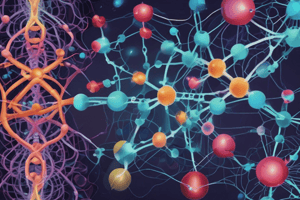Podcast
Questions and Answers
Which of the following is a monomer component of nucleic acids?
Which of the following is a monomer component of nucleic acids?
- 5-carbon sugar, phosphate group, and an amino acid
- 4-carbon sugar, phosphate group, and a nitrogenous base
- 5-carbon sugar, phosphate group, and a nitrogenous base (correct)
- 6-carbon sugar, phosphate group, and a nitrogenous base
Which sugar leads to the polymer being RNA?
Which sugar leads to the polymer being RNA?
- Deoxyribose
- Glucose
- Fructose
- Ribose (correct)
What is the role of nucleic acids in living cells?
What is the role of nucleic acids in living cells?
- Produce energy for the cell
- Regulate cell size
- Facilitate cell division
- Carry information and make up genetic material (correct)
Which bases are found in both RNA and DNA?
Which bases are found in both RNA and DNA?
What is the difference in the structure of the chains formed by RNA and DNA?
What is the difference in the structure of the chains formed by RNA and DNA?
Flashcards are hidden until you start studying
Study Notes
Monomer of Nucleic Acids
- Nucleotides serve as the monomer components of nucleic acids, consisting of a sugar, a phosphate group, and a nitrogenous base.
Sugar Leading to RNA
- Ribose is the sugar that leads to the formation of RNA polymers, differentiating it from DNA, which contains deoxyribose.
Role of Nucleic Acids in Living Cells
- Nucleic acids, including DNA and RNA, are crucial for storing, transmitting, and expressing genetic information within living cells.
- They play key roles in protein synthesis, acting as templates for translating genetic codes into functional proteins.
Common Bases in RNA and DNA
- Adenine (A) and Guanine (G) are nitrogenous bases found in both RNA and DNA, facilitating vital processes such as genetic coding and the production of proteins.
Structural Differences Between RNA and DNA
- RNA typically consists of a single-stranded chain, while DNA is double-stranded, forming a helical structure.
- The presence of ribose in RNA versus deoxyribose in DNA contributes to differences in stability and function between the two types of nucleic acids.
Studying That Suits You
Use AI to generate personalized quizzes and flashcards to suit your learning preferences.




